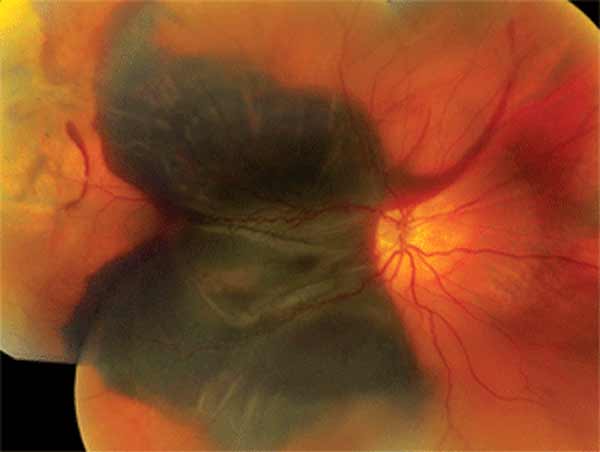 |
Close monitoring for signs of submacular hemorrhage may be warranted for AMD patients taking blood-thinning medication. Photo: Mark Dunbar, OD. Click image to enlarge. |
For patients with age-related macular degeneration (AMD), the development of extensive submacular hemorrhage can be vision-threatening even despite the beneficial effects of surgical intervention. The findings of a new study being presented this afternoon at ARVO 2023 in New Orleans suggest extra caution be taken particularly when monitoring patients on blood thinners, as the data showed these drugs can significantly increase the size and severity of submacular hemorrhage.
“Systemic blood-thinning drugs, which are commonly prescribed in the same age group [as AMD] are known to increase the overall risk of severe hemorrhage in many parts of the body,” the team of German researchers wrote in their abstract. To investigate the potential association of submacular hemorrhage severity with various types of blood thinners, the group reviewed the medical records of 175 patients who underwent surgery for submacular hemorrhage between 2019 and 2022 (mean age: 83). The average size of submacular hemorrhage was 33.62mm2, and the average best-corrected visual acuity (BCVA) was 1.58logMAR at initial presentation and 1.47logMAR one year post-op.
Nearly three-quarters of study patients were on blood thinners (73.4%). The researchers reported in their abstract that “the size of submacular hemorrhage was significantly larger in patients on blood-thinning medication (36.03mm2 vs. 21.73mm2) and their BCVA postoperatively was worse” after one year, at 1.63logMAR vs. 1.32logMAR for unmedicated subjects. They also observed a difference in outcomes depending on the type of blood thinners being taken. Compared with direct oral anticoagulants, they reported that patients with vitamin K antagonists (e.g., warfarin) had larger submacular hemorrhage size and worse BCVA outcomes.
These study results provide convincing evidence of the potential increased severity of hemorrhage in patients with AMD on blood thinners. Therefore, the researchers concluded, “the indication for their intake should be critically evaluated.”
Original abstract content © Association for Research in Vision and Ophthalmology 2023.
Liegl RG, Weber C, Bertelsmann M, et al. Blood thinners in patients with submacular hemorrhage secondary to neovascular AMD. ARVO 2023 annual meeting. |


